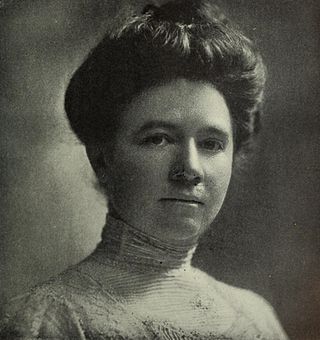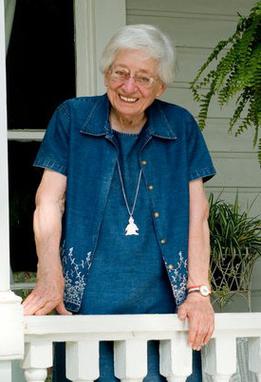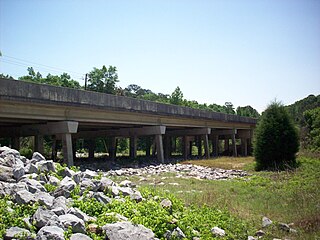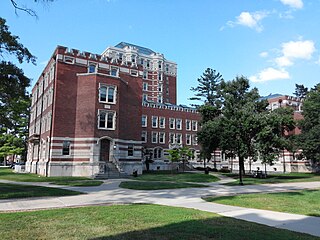
The Red Lady of Huntingdon College is a ghost said to haunt the former Pratt Hall dormitory at Huntingdon College in Montgomery, Alabama. Her story is told in Huntingdon alumnus Kathryn Tucker Windham's book 13 Alabama Ghosts and Jeffrey .

The Red Lady of Huntingdon College is a ghost said to haunt the former Pratt Hall dormitory at Huntingdon College in Montgomery, Alabama. Her story is told in Huntingdon alumnus Kathryn Tucker Windham's book 13 Alabama Ghosts and Jeffrey .
According to Windham and historian Daniel Barefoot, there have actually been two ghosts alleged to have haunted Huntingdon College. They first appeared in the late nineteenth century, while the college was still located in the town of Tuskegee, Alabama. She was described as a young woman wearing a scarlet dress and carrying a scarlet parasol who walked wordlessly up and down the halls of a women's dormitory late one night, bathed in a red glow. This apparition, according to Windham, ultimately left the residence hall and disappeared from view as she passed through a gateway outside. The alleged identity or origin of this wraith has never been determined, and she was apparently never seen again. [1]
The second Red Lady, according to Windham, was a former student named Martha (according to Windham) or Margaret (according to another source; no last name for this alleged person has ever been offered) who had reluctantly come to Huntingdon from New York, because her father's mother had attended Huntingdon when it was in Tuskegee, and his will specified that she must attend his mother's alma mater. Martha did not especially want to come to Alabama, but her father's fortune was large and she knew his deep love for his home state. Martha, according to the legend, was dressed in red when she arrived, and she brought with her red draperies for her windows and a red spread for her bed together with other accessories of the same color. Although many of her fellow students asked her to explain her apparent obsession with the color red, Martha always demurred. [2]
Being a stranger and shy, as well as unhappy in her unfamiliar surroundings, Martha could not make friends among the students. They sensed that she was different from them, and having heard she was wealthy, they mistook her shyness for disdain. Martha sat alone and apart from them in the dining hall, and seldom spoke to her roommate. When other girls (Huntingdon was an all-female institution at this time) dropped in to visit, she seemed so cold and unfriendly that they eventually stopped coming. Truthfully, many of them had only come out of curiosity to see the red prayer rug Martha had bought in Turkey and the odd little red figurines on her bookshelves. [3]
Martha's roommate, according to Windham's story, ultimately found the situation unbearable and asked the housemother if she could move out. The housemother granted this request and put someone else in the room with Martha, who became increasingly aloof and irritable. This second girl also left her after only a week. This procedure happened again and again as one roommate after another found it impossible to live with the surly girl. At last the president of the dormitory, who was known for her ability to get along with everybody, moved in with Martha and did everything she could to make friends with her, but all efforts were futile. Martha had become embittered as well as withdrawn, and she seemed to resent the presence of this kindhearted girl. [4]
After all her efforts at friendship had failed and after she found herself growing depressed and despondent, the dormitory president packed her belongings and prepared to leave. Just as she was about to go, Martha, who had not known of her imminent departure, returned to the room. With a look of defiance she said (according to Windham's story), "So you couldn't stand me either - like all the rest of your stuck up friends. I was beginning to think you really wanted me to be your friend but you hate me just like the rest. Well, I'm glad to be rid of you! Take your things and go! But I'll tell you one thing, my dear: for the rest of your life you'll regret leaving this room." The house president was disturbed by this bitter outburst but in the midst of her many activities she soon forgot about Martha's prophetic words. [5]
The sad girl, abandoned by the one person she had believed to be her only friend, allegedly formed the habit of wandering into rooms where the other girls were congregating, but her presence cast a chill upon the groups and they would soon find flimsy excuses for leaving her alone. Then, with a feeling of alienation from all humankind, she would return to her solitary sleeping quarters, where she would wrap herself in her red bedspread and retreat from the whole world. [6]
Later, Martha's behavior allegedly became even more strange: She would wait until the lights were out, and then she would visit one dormitory after another, never saying a word but staring into space as if she were in a trance. As time passed, she took to walking up and down the halls during the darkest hours of the night. Often she would alarm the girls by opening and closing their doors, then hurrying away to resume her pitiful promenade. [7]
One evening after Martha had not appeared for classes or meals all day, her former roommate, the dormitory president, had a guilty feeling and decided to go see her, thinking that this time she might be able to help Martha in some way. As she neared Martha's room at an isolated corridor at the top floor of the building, she is said to have noticed flashes of red shooting out into the corridor from the room's transom. Opening the door, she screamed and fainted. Girls from all over the fourth floor of Pratt rushed from their rooms to see what was wrong. Martha, or so the story goes, was found on the floor of her room, dressed in her red robe and draped in her red bedspread, having committed suicide by slashing her wrists. [8]
This happened "a long time ago", according to Windham, but students at Huntingdon have alleged that on the date of Martha's suicide each year rays of crimson light flash down from the transom of her room, and the Red Lady returns to haunt the corridors of Pratt Hall. Students have allegedly reported seeing Martha's ghost on Pratt Hall's fourth floor, claiming to have seen it pass through walls or closed doors.
Today, Pratt Hall has been converted from a dormitory to the college's Department of Education and Psychology. [9]
In October every year, the Chi Omega, Phi Mu, and Alpha Omicron Pi sororities at Huntingdon take part in "The Red Lady Run," painting their faces, wearing all black, and running around the campus.
In addition to the Red Lady, Huntingdon College is allegedly haunted by the restless spirit of a young male student who supposedly shot himself on the college green sometime during the 1970s after being jilted by a former girlfriend. Students have allegedly reported feeling unseen forces tugging on their clothes as they walk across the green at night, or mussing their hair, or blowing in their ears. [10] Other spirits alleged to haunt portions of the Huntingdon campus include those of a murdered co-ed, a young boy who allegedly drowned in the college pond, a female student clad only in a towel, and a poltergeist known as "Frank the Library Ghost".

Huntingdon College is a private Methodist college in Montgomery, Alabama. It was founded in 1854 as a women's college.

Martha McChesney Berry was an American educator and the founder of Berry College in Rome, Georgia.

Kathryn Tucker Windham was an American storyteller, author, photographer, folklorist, and journalist. She was born in Selma, Alabama, and grew up in nearby Thomasville.

13 Alabama Ghosts and Jeffrey is a book first published in 1969 by folklorist Kathryn Tucker Windham and Margaret Gillis Figh. The book contains thirteen ghost stories from the U.S. state of Alabama. The book was the first in a series of seven Jeffrey books, most featuring ghost stories from a Southern state. Jeffrey in the book's title refers to a ghost that allegedly haunts Windham's home.

Julia Strudwick Tutwiler was an advocate for education and prison reform in Alabama. She served as co-principal of the Livingston Female Academy, and then the first woman president of Livingston Normal College. She was inducted into the Alabama Women's Hall of Fame in 1971.

Kenworthy Hall, also known as the Carlisle-Martin House, Carlisle Hall and Edward Kenworthy Carlisle House, is a plantation house located on the north side of Alabama Highway 14, two miles west of the Marion courthouse square. It was built from 1858 to 1860 and is one of the best preserved examples of Richard Upjohn's distinctive asymmetrical Italian villa style. It is the only surviving residential example of Upjohn's Italian villa style that was especially designed to suit the Southern climate and the plantation lifestyle. It has a massive four-story tower, windows of variable size and shape with brownstone trim, and a distinctly Southern division of family and public spaces. The building was designed and constructed for Edward Kenworthy Carlisle as his primary family residence and the centerpiece of his 440-acre (1.8 km2) estate. It, along with some of its surrounding ancillary structures, was declared a National Historic Landmark in 2004. The house and a purported ghost are featured as a short story in Kathryn Tucker Windham's 13 Alabama Ghosts and Jeffrey.

William Sketoe, Sr. was a Methodist minister from the south Alabama town of Newton, whose lynching there on December 3, 1864 gave birth to one of Alabama's best-known ghost stories. While locally-told stories of his life usually say that he was hanged on trumped-up charges of desertion from the Confederate Army, other sources show that he was killed for allegedly aiding pro-Union renegades in the area. Whatever the reason for his murder, a shallow hole dug beneath Sketoe's feet during the hanging ultimately led to stories about "the hole that won't stay filled." According to witnesses, this hole never disappeared—even after being filled numerous times—retaining its original dimensions for the next 125 years.

Sarah Ann Padden was an English-born American theatre and film character actress. She performed on stage in the early 20th century. Her best-known single-act performance was in The Clod, a stage production in which she played an uneducated woman who lived on a farm during the American Civil War.

Peabody Hall is a mixed-use academic and residential building located on the campus of Miami University in Oxford, Ohio. The original building, known as Seminary Hall, was built in 1855, and was the central building of Western College for Women. That building burned down in 1860 and was rebuilt the following year, only to become damaged by an 1871 fire. Rebuilt again that same year, the building was renamed Peabody Hall, after Helen Peabody the first head of Western College, in 1905. Peabody Hall is one of two residential buildings on Miami's Western Campus still used for their original purposes. It is one of 15 contributing buildings to the Western Female Seminary National Historic District.
The following are reportedly haunted locations in California, in the United States. This list is sorted by county.

There are a number of reportedly haunted locations in Scotland.

Jewett House is a nine-story Tudor-style dormitory on the campus of Vassar College in the town of Poughkeepsie, New York. Built in 1907 to accommodate increasing demand for residential space, the dorm was designed by Vassar art professor Lewis Pilcher of the architectural firm Pilcher and Tachau. Early reviews looked unfavorably upon Jewett, even dubbing it "Pilcher's Crime" and by 2002, a host of issues plagued the dorm, leading to a $21 million renovation. Up to 195 students of any gender or class year may live in Jewett, which has been purported to be haunted by several different ghosts during its existence.
A Lady in Red or Red Lady is a type of female ghost, similar to the White Lady, but according to legend is more specifically attributed to a jilted lover, killed in a fit of passion, or woman of vanity. Such a figure is thereby seen as a victim of objectification. In all cases, the Lady in Red is wearing a scarlet or blood red dress. She is said to typically be friendly in disposition, with a story attached to historic hotels, theatres or other public places, with a higher frequency of reports.
Madam Koi Koi is a ghost in Nigerian and African urban legend who haunts dormitories, hallways and toilets in boarding schools at night, while in day schools she haunts toilets and students who come to school too early or leave school late. She is often depicted wearing a pair of red heels or wearing a single heel. She is one of the most popular boarding school ghosts in Nigeria, Ghana and South Africa.